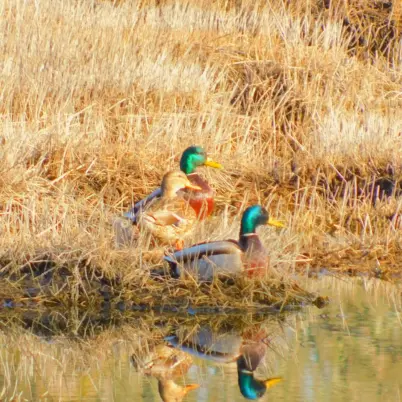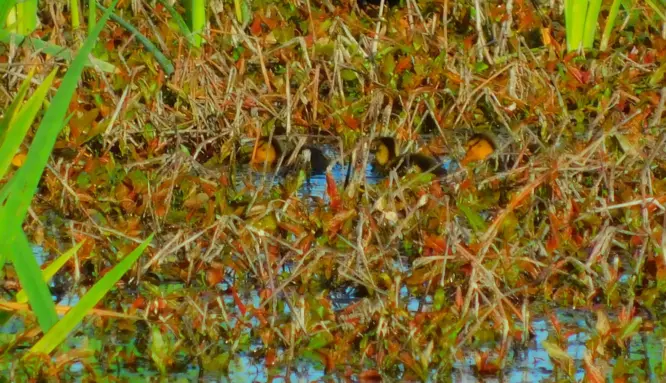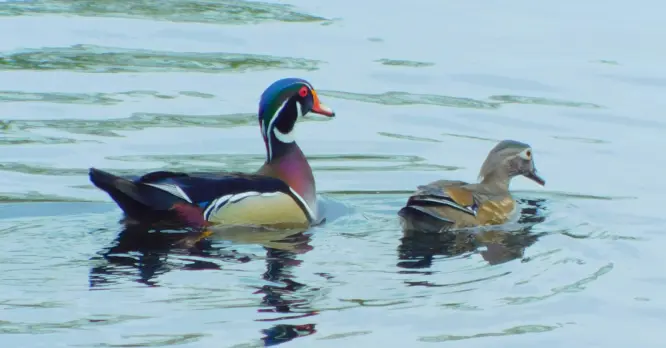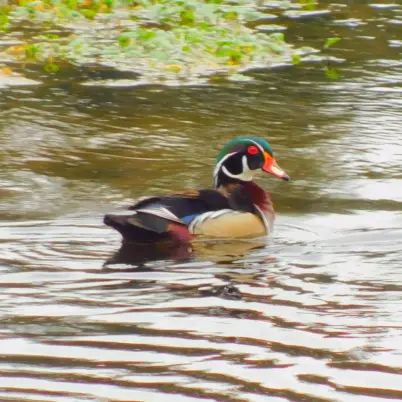Here We Go Gathering Ducks in May
Song of Spring
by Marcia Wilson
“Spring would not be spring without bird songs, any more than it would be spring without buds and flowers…”
–Theodore Roosevelt

It was perfect timing when CPTC’s ducklings showed themselves on the Mother’s Day of 2023.
A lot of factors go into when the first babies of spring pop out of the nest. Key is location, location, location. The paired mallards that normally nest and hatch at Building 15, known as Howard and Bev, moved further down into the wetlands. Their fans suspect this was to avoid on-campus predators like coyotes and raptors.
Howard and Bev are shy and difficult to photograph. Luckily, Howard has a wobble in his left leg which makes him stand out in the crowd. The birdwatchers spotted him paddling with the other drakes in the marsh and that got their hopes up: Once the eggs are safely in the nest, the parents part ways for another year. Researchers suggest the larger and more colorful males lure potential predators away from the nest by making themselves a more attractive target.

Ducks in a Row for 2024
On May 3, something small and yellow was seen following their mother being a clump of Yellow Flag.
There is no way of knowing if these ducklings belong to “our” Howard and Bev, but they are a welcome sight. Waterfowl fulfil a vital ecological role in the health of wetlands. Mallards are taken for granted because they are “ordinary” and “common” but they are needed. They are not just a valuable food for other animals; they can thrive on a diet of invasive or aggressive weeds that affect the waterways.
The ducklings in the above photo were foraging for food in a persicaria bed. These are native “smartweeds” and grow aggressively in urban areas where there are finite amounts of wildlife to take care of their excessive numbers. Ducks, in other words, are ducky for city budgets.
Drake or Mallard?
It is very important to use the proper names for anything, but when it comes to waterfowl, English-speaking humans have challenges.
To begin with, the noun mallard means any male, wild duck. Unfortunately, so does drake. The Mallard Duck is an umbrella label that incorporates mature male ducks of the Anas platyrhynchos species–but also the mature hens, the juveniles of both genders, and the ducklings. Anas lacks clarity because it can be used for ducks, geese and swans. Platyrhynchos isn’t much help for the curious because it means “flat-nosed being/organism”. Going back at about 700 years, mallard meant a wild drake, which was applied to just about any duck that lived on its own devices without man’s help. Back then, for the record, that was considered noteworthy as there were definite human-centric attitudes to how things were supposed to operate.
How Much Wood Will a Wood Duck Duck?
The answer is, they don’t “duck” the woods. Wood Ducks are designed for living in quiet waters close to the forests. They need the Pacifc Rainforest woods for nesting and if they have no trees they must make do with man-made nesting boxes. If they are too close to another Wood Duck’s tree, the parents may lay eggs in the wrong nest! They need to be high up and thus evolved with sharp, strong claws at the end of each webbed toe for gripping the branches.
They are small ducks, a little bigger than a crow. This gives them some advantages to hiding from predators. In good years they can lay two separate clutches of eggs.
Wood Ducks are beautiful, which distracts from their strange, cartoonish look. To quote All About Birds
“Wood Ducks have a unique shape among ducks—a boxy, crested head, a thin neck, and a long, broad tail. In flight, they hold their head up high, sometimes bobbing it. Overall, their silhouette shows a skinny neck, long body, thick tail, and short wings.”
If they weren’t so beautiful they would be an object of confusion and amusement more than admiration. Aviation engineers often note the bird’s short, stubby wings and tailfeathers bird make them ideal for flying through forests, unlike the rest of their brethren.

Below: Closeup Photo of a male trying to get the attention of a hen. He was so caught up in his courtship, he didn’t realize he was the only applicant for the dance.

Wood You Listen to That?
The CPTC wetlands in spring is an open invitation to listen to some remarkable birds. Wood Ducks have an incongruous call: For all their flash and blare they sound like angry chipmunks. For this reason, Hollywood film-makers and sound auditors often splice the sounds of other “dramatic” birds over the film when the shot cuts to their scene.
